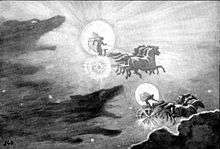Fjörgyn and Fjörgynn
Fjörgyn (or Jörð; Old Norse 'earth') is the personification of the earth in Norse mythology, and the mother of the thunder god Thor, the son of Odin. The masculine form Fjörgynn is portrayed as the father of the goddess Frigg, the wife of Odin.[1]
Both names appear in the Poetic Edda, compiled in the 13th century from earlier traditional sources, and in the Prose Edda, written in the 13th century by Snorri Sturluson. A number of theories surround the names and they have been the subject of scholarly discourse.
Name
Etymology
The Old Norse name Fjörgyn is used as a poetic synonym for 'land' or 'the earth' in skaldic poems.[2][1][3] It stems from Proto-Germanic *fergunja, meaning 'mountain', perhaps 'mountainous forest' (or the feminine equivalent of *ferga, 'god'), which may ultimately derive from Proto-Indo-European *per-kwun-iyā ('the realm of Perkwunos'; i.e., the wooden mountains).[4][5] Fjörgyn is cognate with the Gothic fairguni (𐍆𐌰𐌹𐍂𐌲𐌿𐌽𐌹), the Old English firgen, both meaning 'mountain', or with the Old High German Firgunnea (the Ore Mountains).[5]
Alternative names
Scholars argue that Fjörgyn may simply be another name for Jörð, whose name also means 'earth'.[2][1] The fact that she does not appear elsewhere as a goddess in skaldic poetry "as would be expected of a purely literary alternative to Jörð" may be also notable.[2]
Attestations
Fjörgyn (feminine) is attested in Völuspá in the kenning "Fjörgyn’s son" for Thor, and in Hárbarðsljóð as the mother of Thor.[1]
So keep to the left on the road, until you find Verland;
There Fjörgynn will find Thor, her son,
And she will teach him the ways of kinsmen to Odin’s lands.
In both Gylfaginning (9) and Skáldskaparmál (19), Fjörgynn (masculine) is depicted as the father of Frigg.[1] In Lokasenna ('Loki's flyting'), Loki is responding to Frigg:
Shut up, Frigg! You are Fjörgyn’s daughter
and have ever been most eager for men...
Theories
Divine pair
Hilda Ellis Davidson theorizes that Fjörgyn and Fjörgynn may have represented a divine pair of which little information has survived, along with figures such as the theorized Ullr and Ullin, Njörðr and Nerthus, and the attested Freyr and Freyja.[6]
Proto-Indo-European origin
Theories have been proposed that Fjörgyn (Proto-Germanic: *fergunja) may represent an extension of an earlier Proto-Indo-European thunder or rain god *Perkwunos due to Indo-European linguistic connections between Norse Fjörgyn, the Lithuanian god Perkūnas, the Slavic god Perun and, perhaps, the Vedic rain god Parjanya.[7]
See also
Notes
- Lindow 2002, p. 117.
- Simek 1996, p. 86.
- West 2007, p. 241, 243.
- West 2007, p. 241.
- Kroonen 2013, p. 136.
- Davidson (1990:106, 111)
- Mallory (1989:129).
References
- Davidson, H. R. Ellis (1990). Gods and Myths of Northern Europe. Penguin Books. ISBN 0-14-013627-4
- Kroonen, Guus (2013). Etymological Dictionary of Proto-Germanic. Brill. ISBN 9789004183407.CS1 maint: ref=harv (link)
- Lindow, John (2002). Norse Mythology: A Guide to Gods, Heroes, Rituals, and Beliefs. Oxford University Press. ISBN 978-0-19-983969-8.
- Mallory, J.P. (1989). In Search of the Indo-Europeans: Language, Archaeology and Myth. Thames & Hudson. ISBN 0-500-27616-1
- Simek, Rudolf (1996). Dictionary of Northern Mythology. D.S. Brewer. ISBN 978-0-85991-513-7.
- West, Martin L. (2007). Indo-European Poetry and Myth. Oxford, England: Oxford University Press. ISBN 978-0-19-928075-9.CS1 maint: ref=harv (link)
